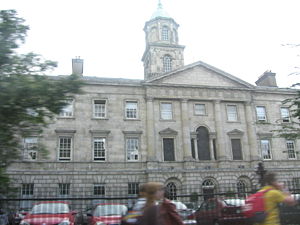
Rotunda Hospital
Encyclopedia

Hospital
A hospital is a health care institution providing patient treatment by specialized staff and equipment. Hospitals often, but not always, provide for inpatient care or longer-term patient stays....
s in the city of Dublin, the others being the The Coombe
Coombe Women's Hospital
The Coombe Women's Hospital is a hospital providing a range of medical services to both women and infants founded in 1826 by Mrs. Margaret Boyle in Dublin, Ireland.-Names:...
and The National Maternity Hospital. The hospital is located just off the top of O'Connell Street
O'Connell Street
O'Connell Street is Dublin's main thoroughfare. It measures 49 m in width at its southern end, 46 m at the north, and is 500 m in length...
, on Parnell Square, on the north side of the city.
The hospital, originally known as "The Dublin Lying-In Hospital", was founded in 1745 by Bartholomew Mosse
Bartholomew Mosse
Bartholomew Mosse was an Irish surgeon and impresario responsible for founding the Rotunda Hospital in Dublin.-Early life:...
(1712-1759), a surgeon
Surgery
Surgery is an ancient medical specialty that uses operative manual and instrumental techniques on a patient to investigate and/or treat a pathological condition such as disease or injury, or to help improve bodily function or appearance.An act of performing surgery may be called a surgical...
and man-midwife who was appalled at the conditions that pregnant mothers had to endure at the time. Initially located in George's Lane on the site of a recently closed theatre, the hospital was later moved to its present location in 1757 where it became known as "The New Lying-In Hospital", referred to today as "The Rotunda".
Records indicate that around 1781, "when the hospital was imperfectly ventilated, every sixth child died within nine days after birth, of convulsive disease; and that after means of thorough ventilation had been adopted, the mortality of infants, within the same, in five succeeding years, was reduced to one in twenty". This issue was not limited to the Lying-In-Hospital. In that era, ventilation improvement was a general issue in patient care. Along with other issues of sanitation and hygiene, and the conditions in which surgeons such as Robert Liston
Robert Liston
Robert Liston was a pioneering Scottish surgeon, and the son of the Scottish minister and inventor Henry Liston, whose father was also a Robert Liston, Moderator of the General Assembly of the Church of Scotland....
in the U.K. and elsewhere, had to operate.
The design of the hospital's main building was undertaken by the renowned architect
Architect
An architect is a person trained in the planning, design and oversight of the construction of buildings. To practice architecture means to offer or render services in connection with the design and construction of a building, or group of buildings and the space within the site surrounding the...
Richard Cassels
Richard Cassels
Richard Cassels , who anglicised his name to Richard Castle, ranks with Edward Lovett Pearce as one of the greatest architects working in Ireland in the 18th century. Cassels was born in 1690 in Kassel, Germany. Although German, his family were of French origin, descended from the...
, who was also responsible for Leinster House
Leinster House
Leinster House is the name of the building housing the Oireachtas, the national parliament of Ireland.Leinster House was originally the ducal palace of the Dukes of Leinster. Since 1922, it is a complex of buildings, of which the former ducal palace is the core, which house Oireachtas Éireann, its...
, Russborough House and Powerscourt
Powerscourt Estate
Powerscourt Estate , located near Enniskerry, County Wicklow, Ireland, is a large country estate which is noted for its house and landscaped gardens, today occupying 19 hectares . The house, originally a 13th century castle, was extensively altered during the 18th century by German architect...
House, among others.
Because it was a charitable institution, the hospital had several public function rooms in which fundraising activities were held. One of these areas was a large rotunda
Rotunda (architecture)
A rotunda is any building with a circular ground plan, sometimes covered by a dome. It can also refer to a round room within a building . The Pantheon in Rome is a famous rotunda. A Band Rotunda is a circular bandstand, usually with a dome...
, after which the hospital is now named, but which is now a part of the Gate Theatre
Gate Theatre
The Gate Theatre, in Dublin, was founded in 1928 by Hilton Edwards and Micheál Mac Liammóir, initially using the Abbey Theatre's Peacock studio theatre space to stage important works by European and American dramatists...
.
The Rotunda, as both a maternity hospital and also as a training centre (affiliated with Trinity College, Dublin
Trinity College, Dublin
Trinity College, Dublin , formally known as the College of the Holy and Undivided Trinity of Queen Elizabeth near Dublin, was founded in 1592 by letters patent from Queen Elizabeth I as the "mother of a university", Extracts from Letters Patent of Elizabeth I, 1592: "...we...found and...
) is notable for having provided continuous service to mothers and babies since inception, making it the oldest continuously operating maternity hospital in the world. It is estimated that over 300,000 babies have been born there. In 1889, the first caesarean section
Caesarean section
A Caesarean section, is a surgical procedure in which one or more incisions are made through a mother's abdomen and uterus to deliver one or more babies, or, rarely, to remove a dead fetus...
performed in Ireland was performed at the Rotunda.

